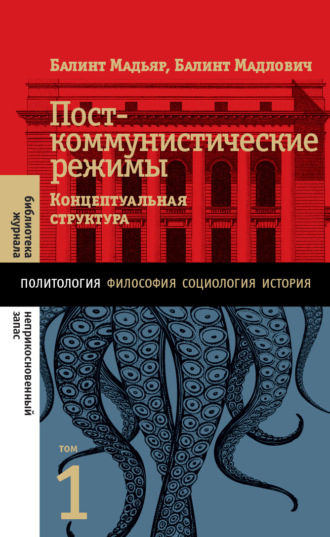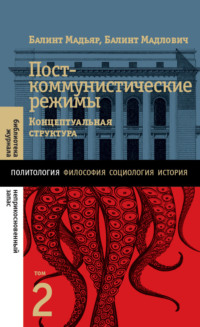
Полная версия
Посткоммунистические режимы. Концептуальная структура. Том 1
80
Offe C. Political Corruption: Conceptual and Practical Issues // Building a Trustworthy State in Post-Socialist Transition. Political Evolution and Institutional Change. New York: Palgrave MacMillan, 2004. P. 78.
81
Каждый вариант, главным образом либеральная демократия и коммунистическая диктатура, будет подробно проанализирован в следующих главах.
82
Хантингтон С. Политический порядок в меняющихся обществах. М.: Прогресс-Традиция, 2004. С. 77.
83
О преодолении эффекта колеи см.: Garud R., Karnøe P. Path Dependence and Creation. Mahwah: Psychology Press, 2001. Пример интерпретации в социальных науках см.: McCloskey D. Bourgeois Equality: How Ideas, Not Capital Or Institutions, Enriched the World. Chicago; London: University of Chicago Press, 2017.
84
Козак считает, что так происходит из-за скорее «восточного», чем «западного» набора ценностей, а Чизмадия утверждает, что факторы, которые делают либеральную демократию в Венгрии несостоятельной, это слабое национальное государство и демократические традиции, слабая социальная организационная сила либерализма, слабая сплоченность общества и социальная ответственность, обусловленные отсутствием политического образования. См.: Kozák M. Western Social Development with an Eastern Set of Values? // Twenty-Five Sides of a Post-Communist Mafia State. Budapest; New York: CEU Press, 2017. P. 373–387; Csizmadia E. A Magyar Politikai Fejlődés Logikája: Összehasonlítható-e a Jelen a Múlttal, s Ha Igen, Hogyan? Budapest: Gondolat Kiadó, 2017.
85
Polányi K. The Great Transformation: The Political and Economic Origins of Our Time. Boston: Beacon Press, 2001. P. 55–81.
86
Acemoğlu D., Johnson S., Robinson J. The Rise of Europe: Atlantic Trade, Institutional Change, and Economic Growth // American Economic Review. 2005. Vol. 95. № 3. P. 546–579; Raico R. The Theory of Economic Development and the European Miracle // The Collapse of Development Planning. New York; London: NYU Press, 1994. P. 37–58; De Soto H. The Mystery of Capital: Why Capitalism Triumphs in the West and Fails Everywhere Else. New York: Basic Books, 2003.
87
Pomeranz K. The Great Divergence: China, Europe, and the Making of the Modern World Economy. Princeton; Oxford: Princeton University Press, 2000.
88
Henderson W. O. Industrial Revolution on the Continent: Germany, France, Russia 1800–1914. London: Routledge, 2013.
89
Хантингтон С. Столкновение цивилизаций. М.: АСТ, 2003.
90
Katzenstein P. J. A World of Plural and Pluralist Civilizations: Multiple Actors, Traditions, and Practices // Civilizations in World Politics: Plural and Pluralist Perspectives. London; New York: Routledge, 2010. P. 1–40.
91
Обзор замечаний см.: Orsi D., ed. The «Clash of Civilizations» 25 Years On: A Multidisciplinary Appraisal. Bristol: E-International Relations, 2018.
92
Пример метаанализа см.: Arnason J. P. Civilizational Analysis, History Of // International Encyclopedia of the Social and Behavioral Sciences. Vol. 3. Oxford; New York: Elsevier, 2001.
93
Katzenstein P. A World of Plural and Pluralist Civilizations P. 29.
94
Katzenstein P. A World of Plural and Pluralist Civilizations P. 24–35.
95
Ibid. P. 12.
96
Ibid. P. 7.
97
Katzenstein P. A World of Plural and Pluralist Civilizations P. 7.
98
Пример метаанализа см.: Deneulin S., Rakodi C. Revisiting Religion: Development Studies Thirty Years On // World Development. 2011. Vol. 39. № 1. P. 45–54. Критику Хантингтона см.: Baumgartner J., Francia P., Morris J. A Clash of Civilizations? The Influence of Religion on Public Opinion of U. S. Foreign Policy in the Middle East // Political Research Quarterly. 2008. Vol. 61. № 2. P. 171–179; Johns R., Davies G. Democratic Peace or Clash of Civilizations? Target States and Support for War in Britain and the United States // The Journal of Politics. 2012. Vol. 74. № 4. P. 1038–1052.




